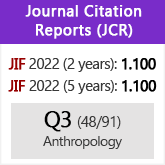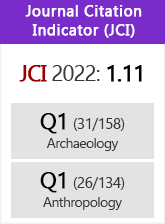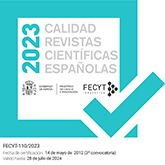Dating of Las Mesas Copper Age walled enclosure (La Fuente, Spain)
DOI:
https://doi.org/10.3989/tp.2014.12138Keywords:
Luminescence dating, Radiocarbon dating, enclosure, Late Neolithic, Copper Age, Extremadura, Badajoz, SpainAbstract
The site of Las Mesas is located in the west bank of the Guadajira river (La Fuente, Badajoz, Spain). It covers a half hectare and is enclosed by a stone wall. Previous assessments based on site surveys suggested a general chronological span from Late Neolithic period (ca. 3600-2900 BC) through the Copper Age (3rd millennium BC). Excavations revealed a well-constructed wall with bastions and a domestic space at the centre of the site with three occupational phases. Several functional areas and a votive pit are ascribed to the second phase. A deer antler located in a re-cut ritual pit associated to the second phase was dated by AMS-14C. Samples from a living floor assigned to the second phase (SU-9/10) and the basement of a kiln associated with the first phase (SU-18) was dated by optically stimulated luminescence (OSL) using the single aliquot regenerative dose (SAR) protocol on 90-160 m quartz grains. Luminescence profiling analysis of 7 samples taken throughout the archaeological stratigraphy was used to assess variations in luminescence behaviour and relative age through the sequence, using infrared-, optically –and thermally– stimulated luminescence (IRSL, OSL, TSL) on poly-mineral and etched samples. Luminescence dating and profiling indicates that the upper archaeological layer (SU-1B) probably dates to the Late Bronze Age (ca. 1000 BC), but that the sediments in the remainder of this section accumulated during the late Neolithic-Copper Age: the site was most probably inhabited between 3300 and 2900 BC. There were gaps in occupation between the Late Neolithic-Cooper Age phases (I & II), and between the Late Neolithic-Cooper Age phases and Late Bronze Age phase (II & III), indicating that the site was abandoned and reoccupied twice. The AMS-14C date on deer antler of 4254 ± 45 BP (3010-2675 cal BC) is consisten with the OSL results for phase II, indicating that the pit was excavated at the beginning of the second occupational phase. Combined OSL and AMS-14C dating shows that Las Mesas site was first occupied during Late Neolithic farming colonization, abandoned during the Copper Age and occupied again during the Late Bronze Age. The occupational gap recorded during the Copper Age relates to evidence for burning of the site and the partial destruction of the wall, followed by its reconstruction and consolidation.
Downloads
References
Aitken, M. J. 1985: Thermoluminescence Dating, U.S. ed. Academic Press. London.
Burbidge, C. I. 2012: "Facets of Luminescence for Dating". Spectroscopy Letters 45: 118-126. http://dx.doi.org/10.1080/00387010.2011.610657
Burbidge, C. I.; Sanderson, D. C. W.; Housley, R. A. and Allsworth Jones, P. 2007: "Survey of Palaeolithic sites by luminescence profiling, a case study from Eastern Europe". Quaternary Geochronology 2: 296-302. http://dx.doi.org/10.1016/j.quageo.2006.05.024
Dias, M. I. y Prudêncio, M. I. 2007: "Neutron Activation Analysis of Archaeological Materials: An Overview of the Itn Naa Laboratory, Portugal". Archaeometry 49: 383-393. http://dx.doi.org/10.1111/j.1475-4754.2007.00308.x
Enríquez Navascués, J. J. 1989: Los poblados calcolíticos de la cuenca del Guadiana. Aproximación al estudio de los comprendidos entre las vegas altas y bajas del Guadiana (la comarca de Mérida). Colecciones tesis doctorales. Universidad Complutense de Madrid. Madrid.
Garcia Sanjuán, L. and Hurtado, V. 1997: "Los inicios de la jerarquización social en el Suroeste de la Península Ibérica (c.2500-1700 ane). Problemas conceptuales empíricos". Saguntum 30: 135-152.
Hurtado, V. 1981: "Las figuras humanas del yacimiento de La Pijotilla (Badajoz)". Madrider Mitteilungen 22: 78-89.
Hurtado, V. 1991: "Informe de las excavaciones de urgencia en 'La Pijotilla'. campaña de 1990". Extremadura Arqueológica II: 45-67.
Hurtado, V. 1995: "Interpretación sobre la dinámica cultural en la Cuenca Media del Guadiana (IV-III milenios ANE)". Extremadura Arqueológica V: 53-80.
Hurtado, V. 1999: "Los inicios de la complejización social y el campaniforme en Extremadura". SPAL 8: 47-83. http://dx.doi.org/10.12795/spal.1999.i8.04
Hurtado, V. 2004: "El asentamiento fortificado de San Blas (Cheles, Badajoz). III milenio AC". Trabajos de Prehistoria 61(1): 141-155. http://dx.doi.org/10.3989/tp.2004.v61.i1.33
Hurtado, V. and Enríquez Navascués, J. J. 1991: "Excavaciones En Palacio Quemado (Alange, Badajoz), Informe Preliminar". Extremadura Arqueológica II: 46-68.
Hurtado, V.; García Rivero, D. and Odriozola, C. P. 2008: Las Mesas. Memoria de excavaciones arqueológicas. Alamut S. L. Estudios de Arqueología y Patrimonio. Badajoz.
Hurtado, V. and Mondejar, P. 2008: "Prospecciones en Tierra de Barros (Badajoz). Los asentamientos del III milenio A.N.E.". En R. Cruz-Auñón Briones and E. Ferrer Albelda (eds.): Estudios de Prehistoria y arqueología en homenaje a Pilar Acosta Martínez. Universidad de Sevilla. Sevilla: 187-206.
Hurtado, V.; Mondejar, P. and Pecero, J. C. 2000: "Excavaciones en La Tumba 3 de La Pijotilla". Extremadura Arqueológica VIII: 249-266.
Murray, A. S. and Wintle, A. G. 2000: "Luminescence Dating of Quartz Using an Improved Single-Aliquot Regenerative-Dose Protocol". Radiation Measurements 32: 57-73. http://dx.doi.org/10.1016/S1350-4487(99)00253-X
Odriozola, C. P.; Hurtado, V.; Dias, M. I. and Prudêncio, M. I. 2008: "Datación por técnicas luminiscentes de la Tumba 3 y el conjunto campaniforme de La Pijotilla (Badajoz, España)". VII Congreso Ibérico de Arqueometría (Madrid 2007): 211-225. Madrid.
Prescott, J. R. and Hutton, J. T. 1988: "Cosmic Ray and Gamma Ray Dosimetry for Tl and Esr". Nuclear Tracks and Radiation Measurements 14: 223-227. http://dx.doi.org/10.1016/1359-0189(88)90069-6
Prescott, J. R. and Stephan, L. G. 1982: "The Contribution of Cosmic Radiation to the Environmental Dose for Thermoluminescent Dating-Latitude, Altitude and Depth Dependences". PACT 6: 17-25.
Reimer, P. J.; Baillie, M. G. L.; Bard, E.; Bayliss, A.; Beck, J. W.; Blackwell, P. G.; Bronk Ramsey, C.; Buck, C. E.; Burr, G. S.; Edwards, R. L.; Friedrich, M.; Grootes, P. M.; Guilderson, T. P.; Hajdas, I.; Heaton, T. J.; Hogg, A. G.; Hughen, K. A.; Kaiser, K. F.; Kromer, B.; McCormac, F. G.; Manning, S. W.; Reimer, R. W.; Richards, D. A.; Southon, J. R.; Talamo, S.; Turney, C. S. M.; van der Plicht, J. and Weyhenmeyer, C. E. 2009: "IntCal09 and Marine09 Radiocarbon Age Calibration Curves, 0-50,000 Years cal BP". Radiocarbon 51, 4: 1111-1150.
Santos Arevalo, F. J.; Gómez Martínez, I. and García León, M. 2009: "Radiocarbon Measurement Programme at the Centro Nacional de Aceleradores (CNA)". Radiocarbon 51, 2: 883-889.
Stuiver, M. and Polach, H. A. 1977: "Discussion: reporting 14C data". Radiocarbon 19, 3: 255-363.
Stuiver, M. and Reimer, P. J. 1993: "Extended 14C data base and revised CALIB 3.0 14C Age calibration program Radiocarbon". Radiocarbon 35, 1: 215-230.
Valera, A. C. 2006: "A margem esquerda do Guadiana (regiao de Mourao), dos finais do 4.º Aos inícios do 2.º Milénio AC". ERA-Arqueologia 7: 136-210.
Downloads
Published
How to Cite
Issue
Section
License
Copyright (c) 2014 Consejo Superior de Investigaciones Científicas (CSIC)

This work is licensed under a Creative Commons Attribution 4.0 International License.
© CSIC. Manuscripts published in both the printed and online versions of this Journal are the property of Consejo Superior de Investigaciones Científicas, and quoting this source is a requirement for any partial or full reproduction.All contents of this electronic edition, except where otherwise noted, are distributed under a “Creative Commons Attribution 4.0 International” (CC BY 4.0) License. You may read here the basic information and the legal text of the license. The indication of the CC BY 4.0 License must be expressly stated in this way when necessary.
Self-archiving in repositories, personal webpages or similar, of any version other than the published by the Editor, is not allowed.

















